Romanian officials are busy destroying their unique heritage – its Saxon fortified churches from the 13th– 16th century, says local watchdogs
Romania prides itself of a treasure of more than 200 Saxon fortified churches built from the 13th – 16th century. Seven of these churches were even registered as UNESCO world heritage in 1993. During the last five years EU has granted more than €20 million to preserve and restore this unique European heritage. However conservationists are in uproar over the so-called restoration, which they claim is more of a “ brutal revamp”.
According to Luke Dale-Harris from Deutsche Welle conservationists are reporting on the same issues. “They describe how traditional plaster has been hacked off with power drills and replaced with cement, traditional wooden beams have been sawed through with chainsaws and ancient engraved tiles deliberately smashed to make way for new, bright red factory-made tiles. Archaeological surveys have either been missed out completely or carried out quickly and inadequately”, he writes.
The Churches in Criţ and Archita
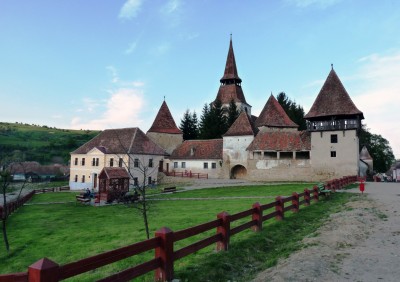 Archita Church in Transylvania before restoration. Source Wikipedia
Archita Church in Transylvania before restoration. Source WikipediaEspecially the treatment of the church in Crit has raised the hackles of the international conservationist-community led by Prince Charles and his Trust Foundation. Prince Charles from England is known as an avid admirer of the Transylvanian countryside and is heavily engaged in preserving both nature and heritage in the nearby village of Viscri.
The church in Criţ is attested in the year 1270, but the fortifications stem from the 16th century. The church itself was rebuilt between 1810 – 1813. The interior is heavily classicised. (Below is a link to a video showing the church after its renovation)
As is usual in Romania local interests have been quick to notice the many millions floating around. More specifically it has been claimed that one particular company, Tondach România, has succeeded in securing the enterprise of repairing the roofs. The result has been a total change of the old handmade tiles with new, industrially produced tiles of a particularly flamboyant red color, says restoration specialists.
The results of this heavy-handed restoration seems to be evident, when looking at photos from “before” and “after” of the Church in Archita (Arkeden), which was built in its present form in the 18th century (only a small part of the church stems from a former Romanesque basilica.)
The Evangelical Lutheran Church
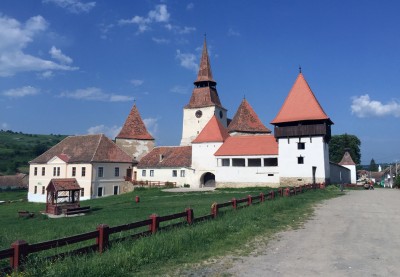 Archita after restoration. Photo by Vince Michael
Archita after restoration. Photo by Vince MichaelIn charge of the restoration campaign has been The Coordination Office for Fortified Churches, run by the Evangelical Church A.C (Biserica Evanghelică C.A). The German President, Joachim Gauck, and the current President of Romania, Klaus Werner Iohannis, are patrons for the institution.
Klaus Werner Iohannis, is the former mayor of Sibiu and a German-speaking Saxon. He is said to be able to trace his roots 850 years back. He was active in 2007, when Sibiu was declared European Cultural Capital and has close relations to the European Commission it is believed he has been a keen supporter in the quest for generous EU-funding for the general restoration of the Transylvanian heritage. He is also known for his negative stance towards the exploitation of the gold-mine in Rosia Montana.
It is the administration of this office and its relationship with local entrepreneurs, which have caught the eye of some watchdogs from Neuer Weg. This is a rejuvenated Communist media, which for political reasons may be critical of the fact that it is the local church authorities, which have been administrating the restoration effort. As might be expected two sets of interests may have clashed here – the need to have pleasant and workable housing for a modern congregation as opposed to a more romantic search for authenticity. It is probable that political conflicts over the criminal investigation against the Social Democratic Prime Minister, Victor Ponta, alleging forgery, complicity in tax evasion and money laundering, also plays a role. In June 2015 National Liberal Iohannis called on Ponta to resign. Currently legal proceedings are underway. In a Romanian context this is also considered an “ethnic” conflict.
According to Deutsche Welle the European Commission is currently planning a seminar to explore the type of restoration of the 18 churches, which has so far taken place.
Saxon Churches
The history behind the Fortified Saxon churches is the immigration of a large contingent of Saxons in the 12th and 13th centuries. Encouraged by the Hungarian kings they settled on the plateau surrounded by the Carpathian Mountains, where they enjoyed special privileges. During the period of Ottoman rule the communities fortified their churches and erected storehouses within the enceintes that they might withstand long sieges.
In German Transylvania was referred to as Siebenbürgen, in Romanian as Transylvania. Before WW2 there were around 300.000 German-speaking Saxons; however, today, they number around 15.000. Part of this is explained by the Romanian persecution during the administration of Ceaușescu, who used to extract money from Germany in order to let the Saxons immigrate. However, the main city in the area, Sibiu or Hermannstadt, is still bilingual and there is a thriving – if poor – Lutheran congregation there. The number of Evangelical Lutherans in the town is 42%, but it is obvious the community is struggling financially; their church is the one crumbling.
Fortified Churches protected by UNESCO
In 1997 UNESCO designated seven fortified churches as World Heritage. The churches are:
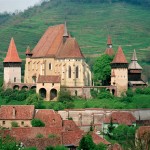 Biertan: Late Gothic hall-type building, completed around 1522-23, on a low hill, with two lines of walls, at the foot of the hill, built at the same time as the church.
Biertan: Late Gothic hall-type building, completed around 1522-23, on a low hill, with two lines of walls, at the foot of the hill, built at the same time as the church.
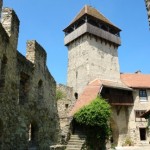 Câlnic: Based on a mid-13th-century dwelling tower, a chapel and an oval enceinte; presented in 1430 to the village community, which raised the walls fitted with two towers and transformed the dwelling tower into one for defensive purposes.
Câlnic: Based on a mid-13th-century dwelling tower, a chapel and an oval enceinte; presented in 1430 to the village community, which raised the walls fitted with two towers and transformed the dwelling tower into one for defensive purposes.
 Prejmer: Early Gothic Church of the Holy Cross, in the shape of a cross; walled in the 15th century.
Prejmer: Early Gothic Church of the Holy Cross, in the shape of a cross; walled in the 15th century.
 Viscri: Romanesque chapel enlarged in the early 16th century to form a single-nave church, with a fortified storey resting on semicircular arches supported by massive buttresses; walls strengthened in the 17th century.
Viscri: Romanesque chapel enlarged in the early 16th century to form a single-nave church, with a fortified storey resting on semicircular arches supported by massive buttresses; walls strengthened in the 17th century.
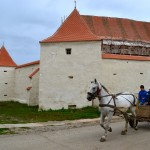 Dârjiu: Late Gothic church fortified towards 1520, decorated with murals going back to 1419; rectangular enceinte restructured in the 17th century.
Dârjiu: Late Gothic church fortified towards 1520, decorated with murals going back to 1419; rectangular enceinte restructured in the 17th century.
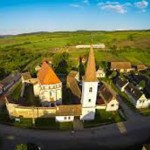 Saschiz: Romanesque church and its enceinte replaced by a late Gothic church (1493-1525); defensive storey gives the church the appearance of a high bastion.
Saschiz: Romanesque church and its enceinte replaced by a late Gothic church (1493-1525); defensive storey gives the church the appearance of a high bastion.
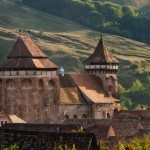 Valea Viilor: Church transformed into late Gothic style and fortified in the early 16th century; defensive storeys built above the choir, nave and tower, communicating with each other; porches of the northern and southern entrances protected by small towers with portcullises.
Valea Viilor: Church transformed into late Gothic style and fortified in the early 16th century; defensive storeys built above the choir, nave and tower, communicating with each other; porches of the northern and southern entrances protected by small towers with portcullises.














Pentru a putea adăuga comentarii trebuie să fii membru al altmarius !
Alătură-te reţelei altmarius